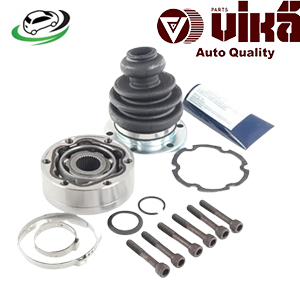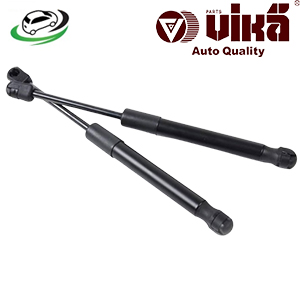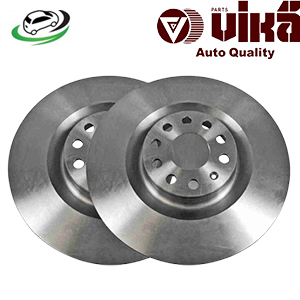-15%
Get Front Brake Disc VW CC-VR6/2.0T / Golf V-2.0T/2.5 / Golf VI-2.0T/2.5/TDI / Passat B6-3.6L/2.0T/3.6L / R32 MKV-3.2 1K0615301AB
The brake disc, also known as the brake rotor, is a crucial component in a vehicle’s braking system. It plays a vital role in slowing down or stopping a vehicle by working in conjunction with the brake pads. Understanding the brake disc’s function, types, common issues, maintenance, and replacement is essential for ensuring optimal braking performance and vehicle safety.
Function of the Brake Disc
The primary function of the brake disc is to provide a surface against which the brake pads clamp to generate the friction necessary to slow down or stop the vehicle. The process involves several key steps:
- Friction Generation: When the brake pedal is pressed, hydraulic pressure pushes the brake pads against the brake disc. The friction between the pads and the disc converts the kinetic energy of the moving vehicle into heat, slowing down the wheels.
- Heat Dissipation: As the brake pads create friction against the disc, substantial heat is generated. The brake disc is designed to dissipate this heat to prevent overheating and maintain effective braking performance.
- Stopping Power: The brake disc’s role is crucial in achieving the necessary stopping power. It needs to withstand significant forces and temperatures while ensuring reliable braking performance.
Types of Brake Discs
Brake discs come in various types, each suited to different driving conditions and performance requirements:
- Solid Discs:
- Description: A single, solid piece of metal.
- Applications: Commonly used in the front or rear brakes of everyday vehicles.
- Pros: Simpler design, generally less expensive.
- Cons: Less effective at heat dissipation compared to ventilated or slotted discs.
- Ventilated Discs:
- Description: Feature internal air channels (or vents) between two disc surfaces.
- Applications: Often used in the front brakes of vehicles due to their better heat dissipation.
- Pros: Improved cooling and heat dissipation, reduced risk of brake fade.
- Cons: Slightly more complex and expensive than solid discs.
- Slotted Discs:
- Description: Have slots or grooves cut into the disc surface.
- Applications: Common in high-performance or racing vehicles.
- Pros: Enhanced grip, better expulsion of gases and debris, improved wet-weather performance.
- Cons: Can wear down brake pads faster, more expensive.
- Drilled Discs:
- Description: Feature holes drilled into the disc surface.
- Applications: Often used in high-performance or racing applications.
- Pros: Improved cooling and heat dissipation, better wet-weather performance.
- Cons: Can be prone to cracking under extreme conditions, reduced pad life.
- Cross-Drilled and Slotted Discs:
- Description: Combine both drilled holes and slots.
- Applications: High-performance and racing applications.
- Pros: Maximum cooling and performance, excellent wet-weather handling.
- Cons: High cost, potential for reduced durability.
Importance of the Brake Disc
The brake disc is essential for several reasons:
- Safety: It provides the necessary friction to slow down or stop the vehicle, ensuring safe driving conditions.
- Performance: High-quality brake discs contribute to better braking performance, including shorter stopping distances and improved vehicle control.
- Heat Management: Effective heat dissipation prevents brake fade and maintains consistent braking performance.
Common Issues with Brake Discs
Brake discs can develop several issues over time, affecting their performance:
- Warping: Excessive heat or uneven cooling can cause the brake disc to warp, resulting in vibrations or pulsations during braking.
- Scoring: Abrasive materials or worn brake pads can score or groove the surface of the disc, reducing braking efficiency.
- Cracking: High temperatures or extreme driving conditions can lead to cracks in the disc, compromising its integrity.
- Corrosion: Exposure to moisture and road salt can cause rust and corrosion on the brake disc, affecting its performance and lifespan.
Signs of Worn or Damaged Brake Discs
Identifying the signs of worn or damaged brake discs can help address issues before they lead to more severe problems:
- Vibrations or Pulsations: Feeling vibrations or pulsations in the brake pedal or steering wheel can indicate warped or unevenly worn discs.
- Grinding Noise: A grinding or squealing noise during braking may signal worn brake pads or scored brake discs.
- Pulling: If the vehicle pulls to one side during braking, it may be due to uneven wear or damage to the brake discs.
- Reduced Braking Performance: Decreased stopping power or increased stopping distances can indicate issues with the brake discs.
Maintenance and Prevention
Proper maintenance and care can extend the life of brake discs and ensure optimal braking performance:
- Regular Inspections: Check the brake discs for signs of wear, scoring, or damage during routine maintenance.
- Replace Brake Pads: Worn brake pads should be replaced promptly to prevent damage to the brake discs.
- Avoid Overheating: Avoid excessive or harsh braking that can lead to overheating and potential warping of the brake discs.
- Clean and Protect: Regularly clean the brake discs to remove debris and protect them from corrosion.
Replacement of Brake Discs
Replacing brake discs is a critical maintenance task that ensures continued braking performance. Here’s a general guide for replacing brake discs:
- Preparation:
- Tools and Materials: Gather necessary tools, including a jack, jack stands, wrenches, and new brake discs.
- Safety Measures: Ensure the vehicle is on a level surface and securely supported on jack stands.
- Remove the Wheel:
- Lift Vehicle: Use a jack to lift the vehicle and remove the wheel to access the brake assembly.
- Remove Old Brake Discs:
- Remove Caliper: Unbolt and remove the brake caliper, being careful not to damage the brake lines.
- Remove Caliper Bracket: If necessary, remove the caliper bracket to access the brake disc.
- Remove Disc: Unscrew any retaining screws or fasteners and remove the old brake disc from the hub.
- Install New Brake Discs:
- Position New Disc: Place the new brake disc onto the hub, aligning it with the mounting holes.
- Secure Disc: Reinstall and tighten any retaining screws or fasteners.
- Reinstall Caliper: Reattach the caliper and caliper bracket, ensuring they are securely fastened.
- Refit Wheel:
- Reinstall Wheel: Put the wheel back on and lower the vehicle to the ground.
- Tighten Lug Nuts: Ensure the lug nuts are tightened to the manufacturer’s specifications.
- Test Drive:
- Performance Check: Start the vehicle and take it for a test drive, monitoring the brakes for proper operation and checking for any unusual noises or issues.
Follow us on Facebook for more parts.



